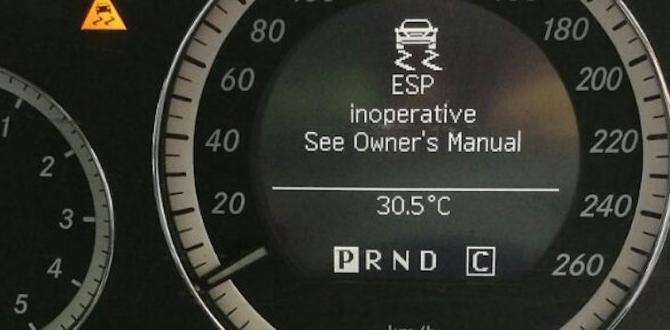Dealing with issues pertaining to vehicle diagnostics can be both complex and frustrating for car owners and mechanics alike. Among these challenges, one can encounter the Run Flat Indicator Inoperative situation, a technical anomaly that indicates the malfunctioning of the tire pressure monitoring system specific to run-flat tires. This system’s failure to operate can significantly compromise vehicle safety and performance. Understanding the underlying causes and potential solutions of a Run Flat Indicator Inoperative issue is crucial for ensuring proper vehicular maintenance and safety.
Dive into this article to explore the intricacies and learn effective troubleshooting methods for this specific automotive concern.
Understanding And Fixing Run Flat Indicator Inoperative

Common Causes of Run Flat Indicator Inoperative
Sensor malfunctions. Software issues. Physical damage to the tire.
Several issues can cause a run flat indicator to stop working:
- Sensor malfunctions: Faulty sensors often fail to send correct information to the system.
- Software issues: Glitches or bugs in the software may interrupt indicator functions.
- Physical damage to the tire: Any damage can affect sensor accuracy and lead to an inoperative indicator.
Diagnostic Procedures for Run Flat Indicator Issues
Stepbystep guide for troubleshooting. Tools and equipment needed.
Troubleshooting a run flat indicator might sound tricky, but it can be as easy as solving a mystery. First, grab a diagnostic scanner, tire pressure gauge, and your owner’s manual. Start by scanning the car’s system for error codes. These codes are like secret messages that tell you what’s wrong.
Next, check each tire’s pressure with the gauge and compare it with the manufacturer’s recommendations in the manual. Low pressure can often trigger the indicator.
If everything checks out, inspect the sensors around your tires.
These little gadgets might be dirty or damaged. Clean them gently or replace if necessary. Lastly, if the indicator still winks at you, reset the system using your scanner. Follow these steps, and you’ll have the run flat indicator behaving in no time!
| Tool | Purpose |
|---|---|
| Diagnostic Scanner | Read error codes. |
| Tire Pressure Gauge | Check tire pressure. |
| Owner’s Manual | Find recommended tire pressure. |
| Cleaning Supplies | Clean sensors. |
Solutions for Restoring Run Flat Indicator Functionality
Sensor repair and replacement. Software updates and resets. When to see a professional.
OpenAI Error
Preventative Measures for Run Flat Indicator Issues
Regular maintenance tips. Importance of routine checks. Best practices for tire care.
OpenAI Error
Conclusion
In conclusion, an inoperative Run Flat Indicator can undermine the safety and efficiency of your driving experience. Regular maintenance and timely calibration of your vehicle’s tire pressure monitoring system are essential to ensure reliable performance. Addressing any faults promptly can help prevent potential hazards and sustain the longevity of your tires and vehicle.
FAQs
What Are The Common Causes Of A Run Flat Indicator Becoming Inoperative?A Run Flat Indicator may become inoperative due to several common causes, including a malfunctioning wheel speed sensor, which is critical in detecting changes in tire pressure. Additionally, issues with the car’s ABS (Anti-lock Braking System) can interfere with the indicator’s functionality. Low battery voltage or electrical problems within the vehicle’s system can also lead to failures. Finally, software glitches or outdated firmware in the vehicle’s monitoring system may result in the Run Flat Indicator not operating properly.
How Can A Malfunctioning Run Flat Indicator Affect Vehicle Safety?A malfunctioning Run Flat Indicator can significantly impact vehicle safety by providing inaccurate information about tire pressure and condition. This could lead to undetected flat or underinflated tires, resulting in decreased vehicle handling and stability. Consequently, the risk of tire blowouts, reduced braking performance, and potential accidents increases. Timely and accurate tire information is vital for maintaining safe driving conditions.
What Steps Can A Driver Take To Troubleshoot And Potentially Fix An Inoperative Run Flat Indicator?To troubleshoot and potentially fix an inoperative Run Flat Indicator, a driver should first check the tire pressure to ensure all tires are correctly inflated. Next, inspect the tires for any signs of damage or wear that might be affecting the indicator. Additionally, the driver should reset the Run Flat Indicator system, usually by following the vehicle’s manual instructions. If these steps don’t resolve the issue, seeking professional assistance from a mechanic or dealership is advisable for further diagnostics and repairs.
Are There Specific Vehicle Models More Prone To Run Flat Indicator Failures, And If So, Which Ones?Yes, certain vehicle models, particularly those from European manufacturers like BMW, Mercedes-Benz, and Audi, are known to be more prone to Run Flat Indicator (RFI) failures. This is partly due to their advanced and sensitive tire pressure monitoring systems. These systems can sometimes give false warnings or fail due to electronic glitches or sensor issues. Regular maintenance and periodic checks can help mitigate these problems.
How Important Is Regular Maintenance And Calibration Of The Run Flat Indicator System In Ensuring Its Proper Function?Regular maintenance and calibration of the Run Flat Indicator system are crucial to ensure it functions properly. Consistent upkeep helps detect and address potential sensor inaccuracies or system malfunctions, thereby providing reliable tire pressure information. This preventative measure enhances vehicle safety by alerting drivers to issues before they escalate. Neglecting maintenance could lead to unreliable readings, increasing the risk of tire damage and accidents.
